Cloud Computing Solutions for ATN Company: HND Computing Project
VerifiedAdded on 2022/03/21
|27
|4750
|19
Report
AI Summary
This report provides a detailed analysis of cloud computing solutions for ATN, a Vietnamese toy company seeking to modernize its data management. The report begins by explaining the evolution and fundamental concepts of cloud computing, emphasizing its advantages for businesses. It then proposes a cloud computing solution tailored to ATN's needs, discussing the appropriateness of various deployment models (Public, Private, Community, Hybrid) and service models (IaaS, PaaS, SaaS). The selection of PaaS is justified based on ATN's requirements. The report also includes an architectural design diagram illustrating the proposed cloud infrastructure, along with discussions on the programming language, web server, and database server choices. The final section provides a comprehensive summary of the recommended cloud computing solution and its benefits for ATN, such as improved data management, real-time stock information updates, and streamlined data analysis for the board director.
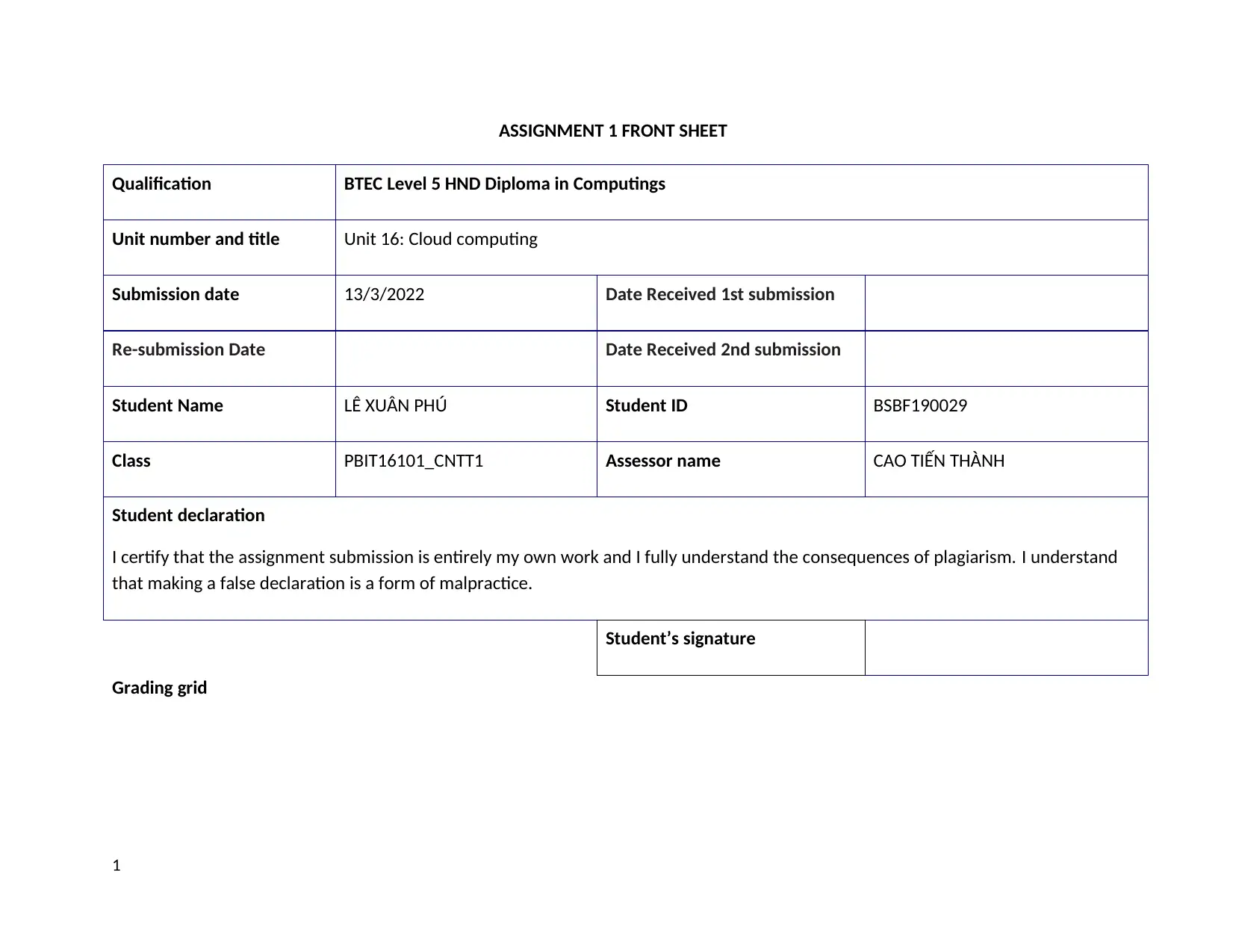
ASSIGNMENT 1 FRONT SHEET
Qualification BTEC Level 5 HND Diploma in Computings
Unit number and title Unit 16: Cloud computing
Submission date 13/3/2022 Date Received 1st submission
Re-submission Date Date Received 2nd submission
Student Name LÊ XUÂN PHÚ Student ID BSBF190029
Class PBIT16101_CNTT1 Assessor name CAO TIẾN THÀNH
Student declaration
I certify that the assignment submission is entirely my own work and I fully understand the consequences of plagiarism. I understand
that making a false declaration is a form of malpractice.
Student’s signature
Grading grid
1
Qualification BTEC Level 5 HND Diploma in Computings
Unit number and title Unit 16: Cloud computing
Submission date 13/3/2022 Date Received 1st submission
Re-submission Date Date Received 2nd submission
Student Name LÊ XUÂN PHÚ Student ID BSBF190029
Class PBIT16101_CNTT1 Assessor name CAO TIẾN THÀNH
Student declaration
I certify that the assignment submission is entirely my own work and I fully understand the consequences of plagiarism. I understand
that making a false declaration is a form of malpractice.
Student’s signature
Grading grid
1
Paraphrase This Document
Need a fresh take? Get an instant paraphrase of this document with our AI Paraphraser
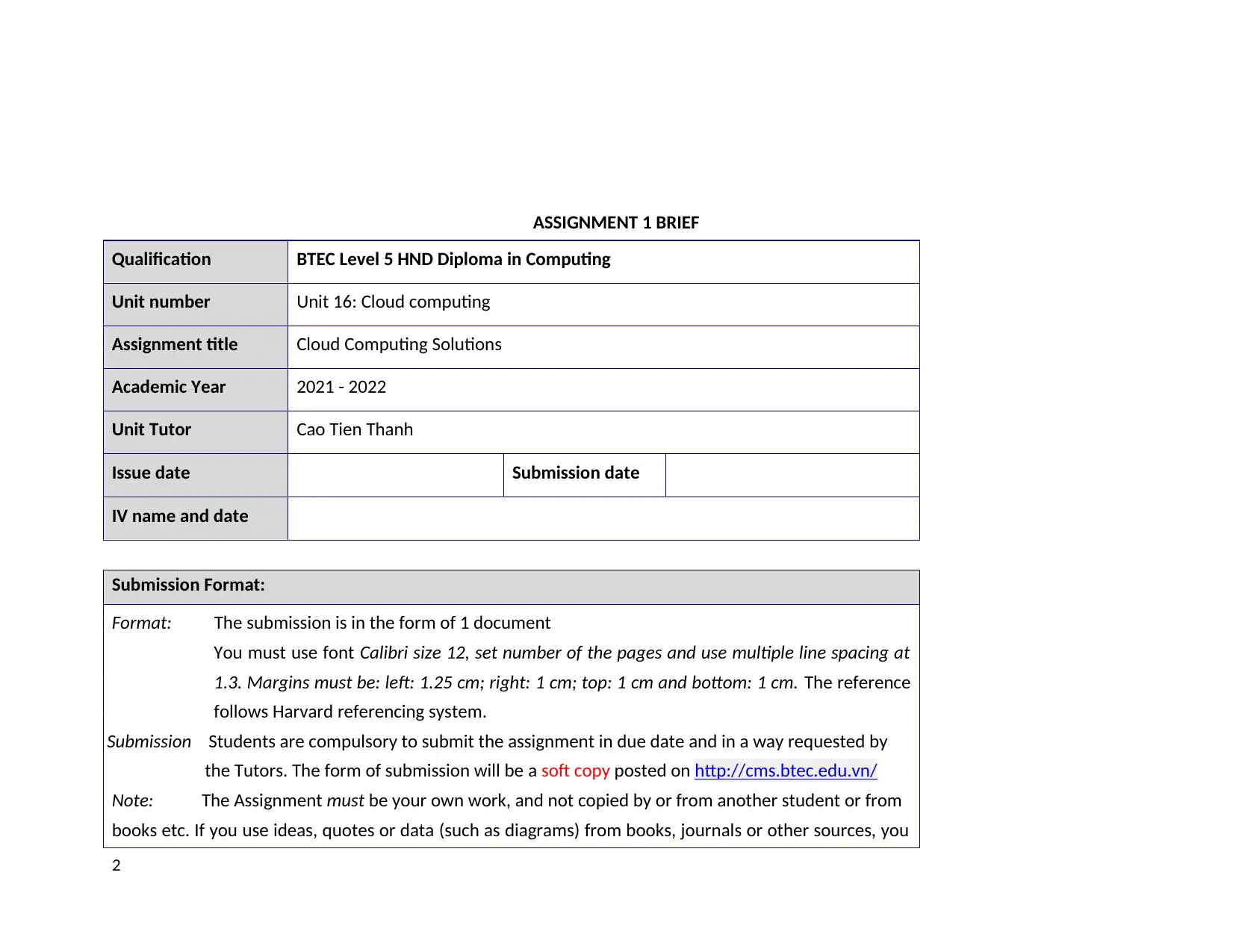
ASSIGNMENT 1 BRIEF
Qualification BTEC Level 5 HND Diploma in Computing
Unit number Unit 16: Cloud computing
Assignment title Cloud Computing Solutions
Academic Year 2021 - 2022
Unit Tutor Cao Tien Thanh
Issue date Submission date
IV name and date
Submission Format:
Format: The submission is in the form of 1 document
You must use font Calibri size 12, set number of the pages and use multiple line spacing at
1.3. Margins must be: left: 1.25 cm; right: 1 cm; top: 1 cm and bottom: 1 cm. The reference
follows Harvard referencing system.
Submission Students are compulsory to submit the assignment in due date and in a way requested by
the Tutors. The form of submission will be a soft copy posted on http://cms.btec.edu.vn/
Note: The Assignment must be your own work, and not copied by or from another student or from
books etc. If you use ideas, quotes or data (such as diagrams) from books, journals or other sources, you
2
Qualification BTEC Level 5 HND Diploma in Computing
Unit number Unit 16: Cloud computing
Assignment title Cloud Computing Solutions
Academic Year 2021 - 2022
Unit Tutor Cao Tien Thanh
Issue date Submission date
IV name and date
Submission Format:
Format: The submission is in the form of 1 document
You must use font Calibri size 12, set number of the pages and use multiple line spacing at
1.3. Margins must be: left: 1.25 cm; right: 1 cm; top: 1 cm and bottom: 1 cm. The reference
follows Harvard referencing system.
Submission Students are compulsory to submit the assignment in due date and in a way requested by
the Tutors. The form of submission will be a soft copy posted on http://cms.btec.edu.vn/
Note: The Assignment must be your own work, and not copied by or from another student or from
books etc. If you use ideas, quotes or data (such as diagrams) from books, journals or other sources, you
2
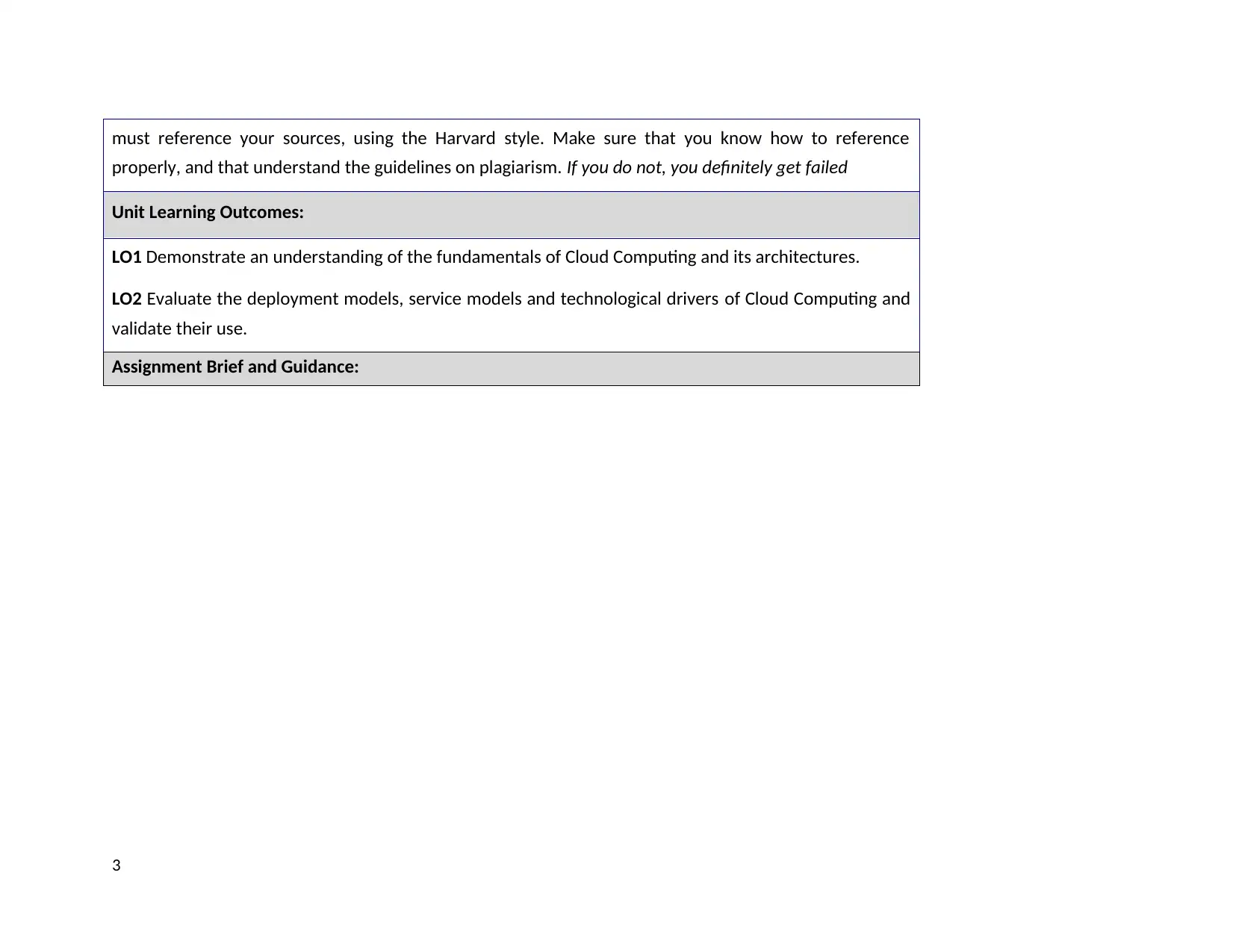
must reference your sources, using the Harvard style. Make sure that you know how to reference
properly, and that understand the guidelines on plagiarism. If you do not, you definitely get failed
Unit Learning Outcomes:
LO1 Demonstrate an understanding of the fundamentals of Cloud Computing and its architectures.
LO2 Evaluate the deployment models, service models and technological drivers of Cloud Computing and
validate their use.
Assignment Brief and Guidance:
3
properly, and that understand the guidelines on plagiarism. If you do not, you definitely get failed
Unit Learning Outcomes:
LO1 Demonstrate an understanding of the fundamentals of Cloud Computing and its architectures.
LO2 Evaluate the deployment models, service models and technological drivers of Cloud Computing and
validate their use.
Assignment Brief and Guidance:
3
⊘ This is a preview!⊘
Do you want full access?
Subscribe today to unlock all pages.

Trusted by 1+ million students worldwide
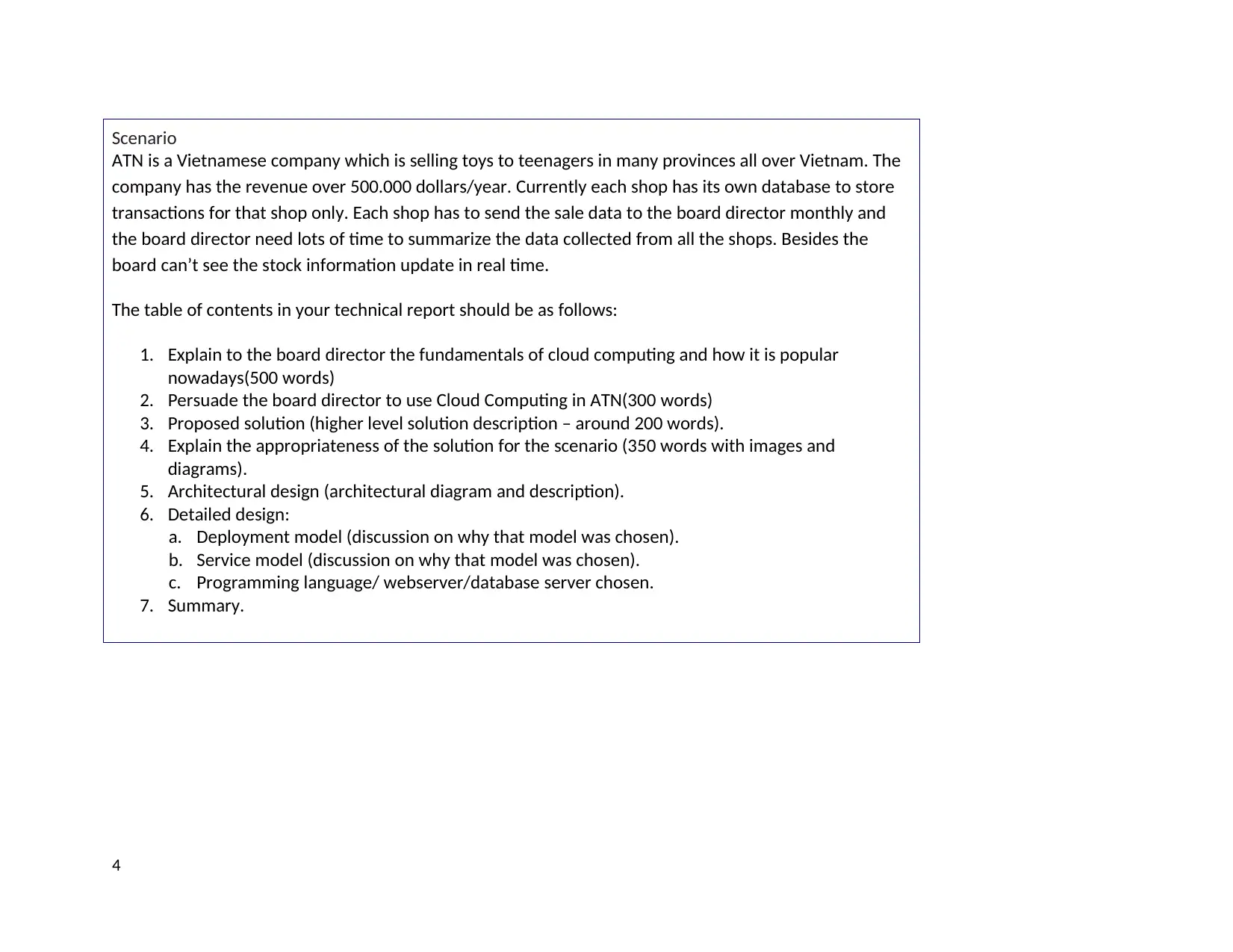
Scenario
ATN is a Vietnamese company which is selling toys to teenagers in many provinces all over Vietnam. The
company has the revenue over 500.000 dollars/year. Currently each shop has its own database to store
transactions for that shop only. Each shop has to send the sale data to the board director monthly and
the board director need lots of time to summarize the data collected from all the shops. Besides the
board can’t see the stock information update in real time.
The table of contents in your technical report should be as follows:
1. Explain to the board director the fundamentals of cloud computing and how it is popular
nowadays(500 words)
2. Persuade the board director to use Cloud Computing in ATN(300 words)
3. Proposed solution (higher level solution description – around 200 words).
4. Explain the appropriateness of the solution for the scenario (350 words with images and
diagrams).
5. Architectural design (architectural diagram and description).
6. Detailed design:
a. Deployment model (discussion on why that model was chosen).
b. Service model (discussion on why that model was chosen).
c. Programming language/ webserver/database server chosen.
7. Summary.
4
ATN is a Vietnamese company which is selling toys to teenagers in many provinces all over Vietnam. The
company has the revenue over 500.000 dollars/year. Currently each shop has its own database to store
transactions for that shop only. Each shop has to send the sale data to the board director monthly and
the board director need lots of time to summarize the data collected from all the shops. Besides the
board can’t see the stock information update in real time.
The table of contents in your technical report should be as follows:
1. Explain to the board director the fundamentals of cloud computing and how it is popular
nowadays(500 words)
2. Persuade the board director to use Cloud Computing in ATN(300 words)
3. Proposed solution (higher level solution description – around 200 words).
4. Explain the appropriateness of the solution for the scenario (350 words with images and
diagrams).
5. Architectural design (architectural diagram and description).
6. Detailed design:
a. Deployment model (discussion on why that model was chosen).
b. Service model (discussion on why that model was chosen).
c. Programming language/ webserver/database server chosen.
7. Summary.
4
Paraphrase This Document
Need a fresh take? Get an instant paraphrase of this document with our AI Paraphraser
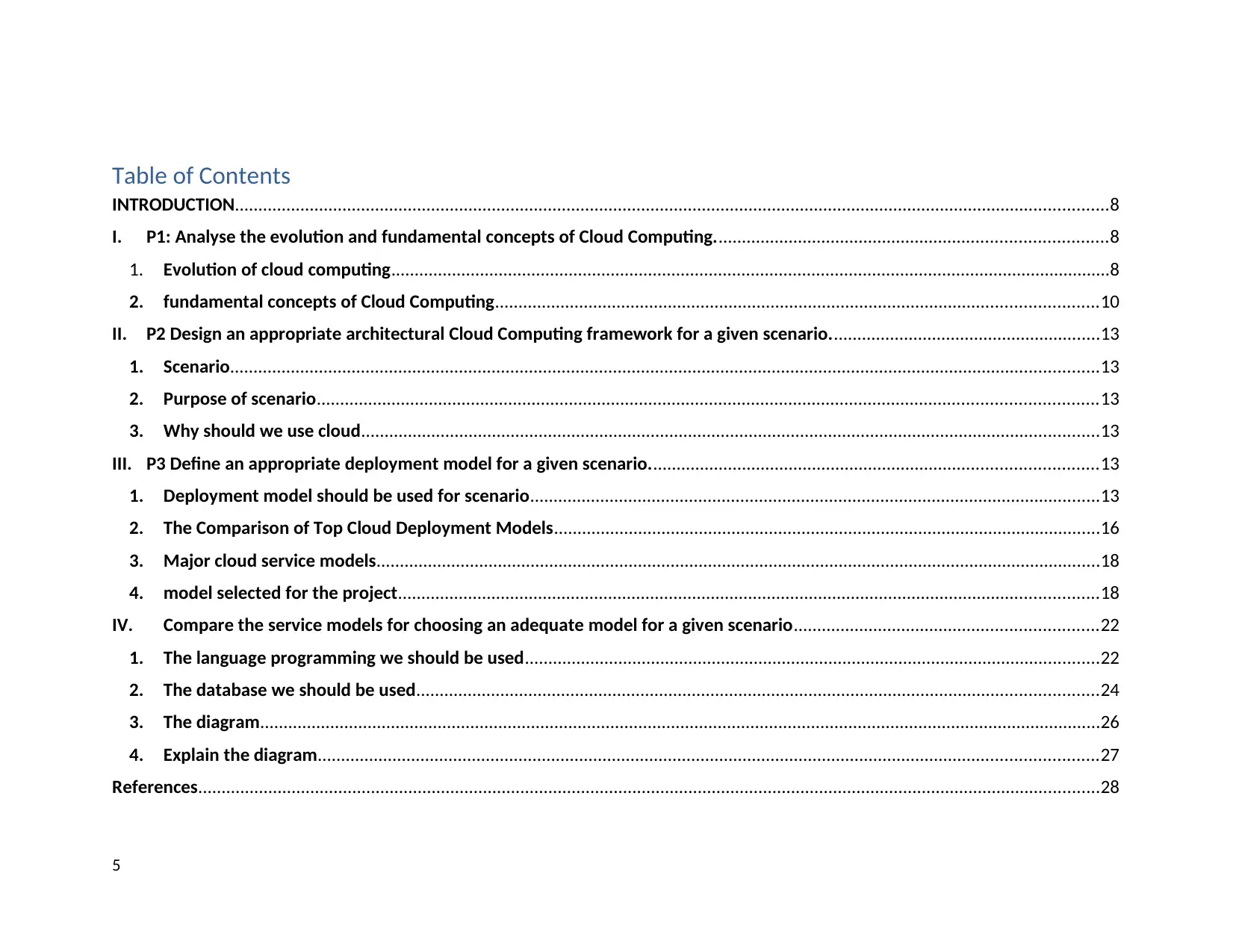
Table of Contents
INTRODUCTION...........................................................................................................................................................................................8
I. P1: Analyse the evolution and fundamental concepts of Cloud Computing....................................................................................8
1. Evolution of cloud computing..........................................................................................................................................................8
2. fundamental concepts of Cloud Computing.................................................................................................................................10
II. P2 Design an appropriate architectural Cloud Computing framework for a given scenario..........................................................13
1. Scenario..........................................................................................................................................................................................13
2. Purpose of scenario.......................................................................................................................................................................13
3. Why should we use cloud..............................................................................................................................................................13
III. P3 Define an appropriate deployment model for a given scenario................................................................................................13
1. Deployment model should be used for scenario..........................................................................................................................13
2. The Comparison of Top Cloud Deployment Models.....................................................................................................................16
3. Major cloud service models...........................................................................................................................................................18
4. model selected for the project......................................................................................................................................................18
IV. Compare the service models for choosing an adequate model for a given scenario.................................................................22
1. The language programming we should be used...........................................................................................................................22
2. The database we should be used..................................................................................................................................................24
3. The diagram....................................................................................................................................................................................26
4. Explain the diagram.......................................................................................................................................................................27
References.................................................................................................................................................................................................28
5
INTRODUCTION...........................................................................................................................................................................................8
I. P1: Analyse the evolution and fundamental concepts of Cloud Computing....................................................................................8
1. Evolution of cloud computing..........................................................................................................................................................8
2. fundamental concepts of Cloud Computing.................................................................................................................................10
II. P2 Design an appropriate architectural Cloud Computing framework for a given scenario..........................................................13
1. Scenario..........................................................................................................................................................................................13
2. Purpose of scenario.......................................................................................................................................................................13
3. Why should we use cloud..............................................................................................................................................................13
III. P3 Define an appropriate deployment model for a given scenario................................................................................................13
1. Deployment model should be used for scenario..........................................................................................................................13
2. The Comparison of Top Cloud Deployment Models.....................................................................................................................16
3. Major cloud service models...........................................................................................................................................................18
4. model selected for the project......................................................................................................................................................18
IV. Compare the service models for choosing an adequate model for a given scenario.................................................................22
1. The language programming we should be used...........................................................................................................................22
2. The database we should be used..................................................................................................................................................24
3. The diagram....................................................................................................................................................................................26
4. Explain the diagram.......................................................................................................................................................................27
References.................................................................................................................................................................................................28
5
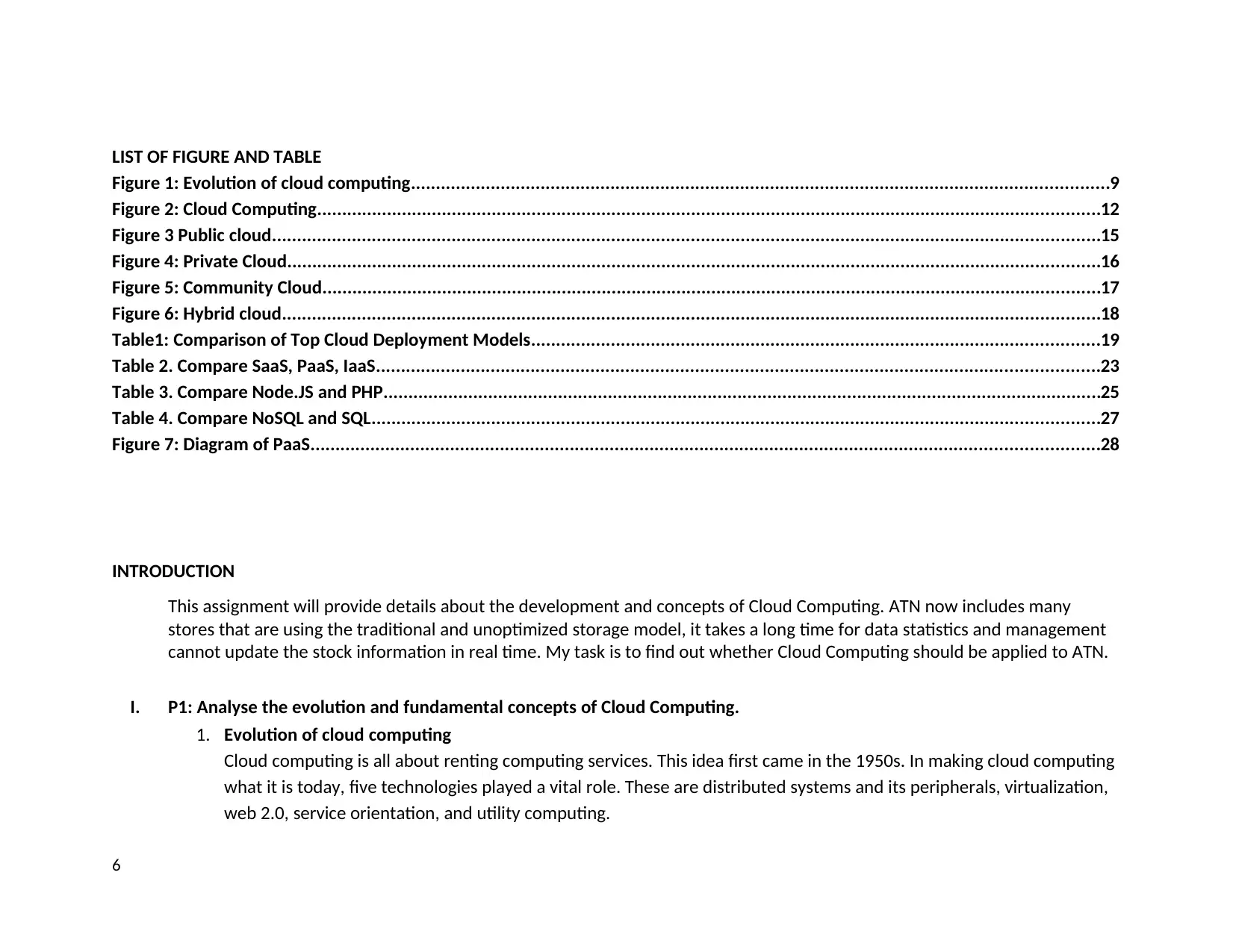
LIST OF FIGURE AND TABLE
Figure 1: Evolution of cloud computing............................................................................................................................................9
Figure 2: Cloud Computing.............................................................................................................................................................12
Figure 3 Public cloud......................................................................................................................................................................15
Figure 4: Private Cloud...................................................................................................................................................................16
Figure 5: Community Cloud............................................................................................................................................................17
Figure 6: Hybrid cloud....................................................................................................................................................................18
Table1: Comparison of Top Cloud Deployment Models..................................................................................................................19
Table 2. Compare SaaS, PaaS, IaaS.................................................................................................................................................23
Table 3. Compare Node.JS and PHP................................................................................................................................................25
Table 4. Compare NoSQL and SQL..................................................................................................................................................27
Figure 7: Diagram of PaaS..............................................................................................................................................................28
INTRODUCTION
This assignment will provide details about the development and concepts of Cloud Computing. ATN now includes many
stores that are using the traditional and unoptimized storage model, it takes a long time for data statistics and management
cannot update the stock information in real time. My task is to find out whether Cloud Computing should be applied to ATN.
I. P1: Analyse the evolution and fundamental concepts of Cloud Computing.
1. Evolution of cloud computing
Cloud computing is all about renting computing services. This idea first came in the 1950s. In making cloud computing
what it is today, five technologies played a vital role. These are distributed systems and its peripherals, virtualization,
web 2.0, service orientation, and utility computing.
6
Figure 1: Evolution of cloud computing............................................................................................................................................9
Figure 2: Cloud Computing.............................................................................................................................................................12
Figure 3 Public cloud......................................................................................................................................................................15
Figure 4: Private Cloud...................................................................................................................................................................16
Figure 5: Community Cloud............................................................................................................................................................17
Figure 6: Hybrid cloud....................................................................................................................................................................18
Table1: Comparison of Top Cloud Deployment Models..................................................................................................................19
Table 2. Compare SaaS, PaaS, IaaS.................................................................................................................................................23
Table 3. Compare Node.JS and PHP................................................................................................................................................25
Table 4. Compare NoSQL and SQL..................................................................................................................................................27
Figure 7: Diagram of PaaS..............................................................................................................................................................28
INTRODUCTION
This assignment will provide details about the development and concepts of Cloud Computing. ATN now includes many
stores that are using the traditional and unoptimized storage model, it takes a long time for data statistics and management
cannot update the stock information in real time. My task is to find out whether Cloud Computing should be applied to ATN.
I. P1: Analyse the evolution and fundamental concepts of Cloud Computing.
1. Evolution of cloud computing
Cloud computing is all about renting computing services. This idea first came in the 1950s. In making cloud computing
what it is today, five technologies played a vital role. These are distributed systems and its peripherals, virtualization,
web 2.0, service orientation, and utility computing.
6
⊘ This is a preview!⊘
Do you want full access?
Subscribe today to unlock all pages.

Trusted by 1+ million students worldwide
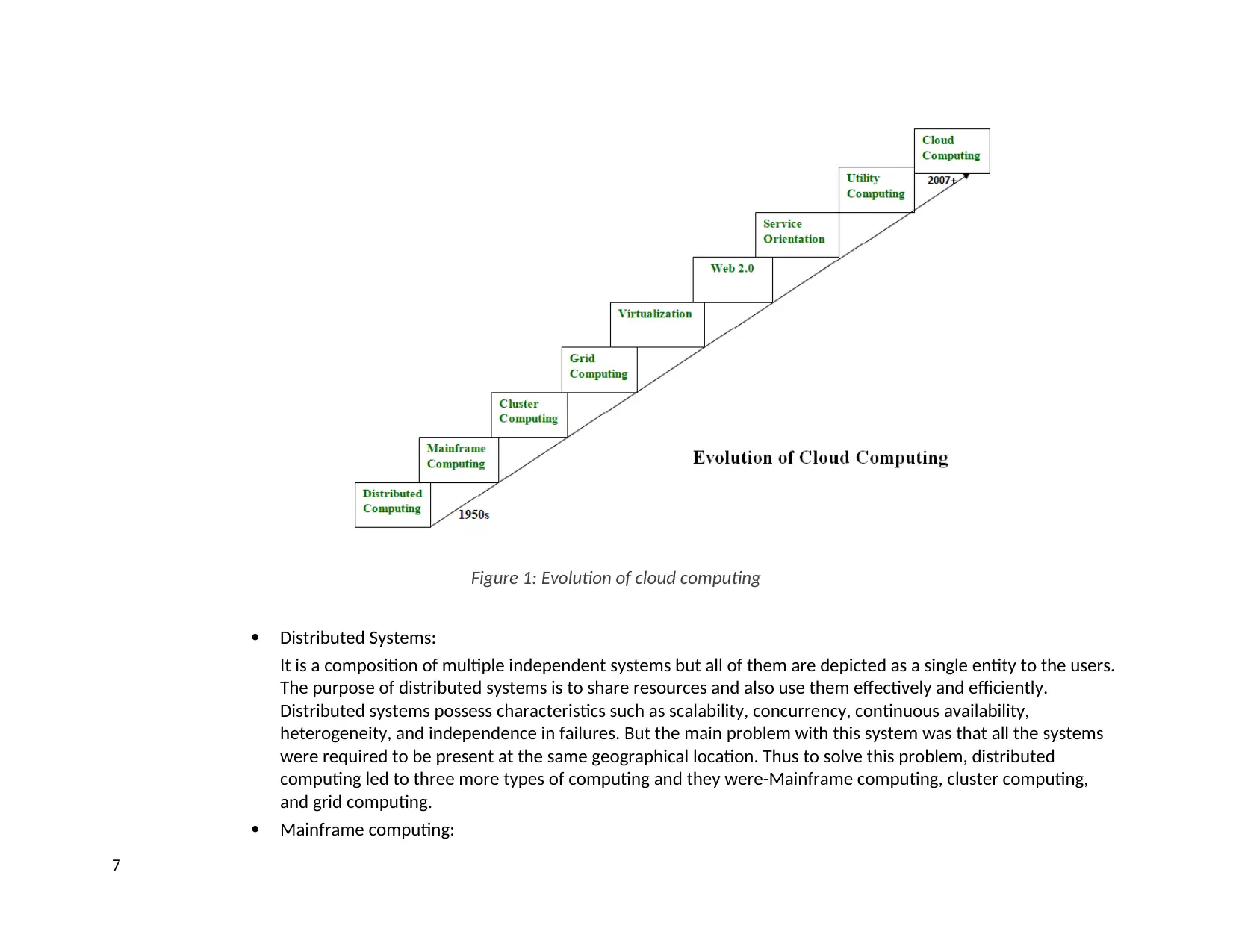
Figure 1: Evolution of cloud computing
Distributed Systems:
It is a composition of multiple independent systems but all of them are depicted as a single entity to the users.
The purpose of distributed systems is to share resources and also use them effectively and efficiently.
Distributed systems possess characteristics such as scalability, concurrency, continuous availability,
heterogeneity, and independence in failures. But the main problem with this system was that all the systems
were required to be present at the same geographical location. Thus to solve this problem, distributed
computing led to three more types of computing and they were-Mainframe computing, cluster computing,
and grid computing.
Mainframe computing:
7
Distributed Systems:
It is a composition of multiple independent systems but all of them are depicted as a single entity to the users.
The purpose of distributed systems is to share resources and also use them effectively and efficiently.
Distributed systems possess characteristics such as scalability, concurrency, continuous availability,
heterogeneity, and independence in failures. But the main problem with this system was that all the systems
were required to be present at the same geographical location. Thus to solve this problem, distributed
computing led to three more types of computing and they were-Mainframe computing, cluster computing,
and grid computing.
Mainframe computing:
7
Paraphrase This Document
Need a fresh take? Get an instant paraphrase of this document with our AI Paraphraser
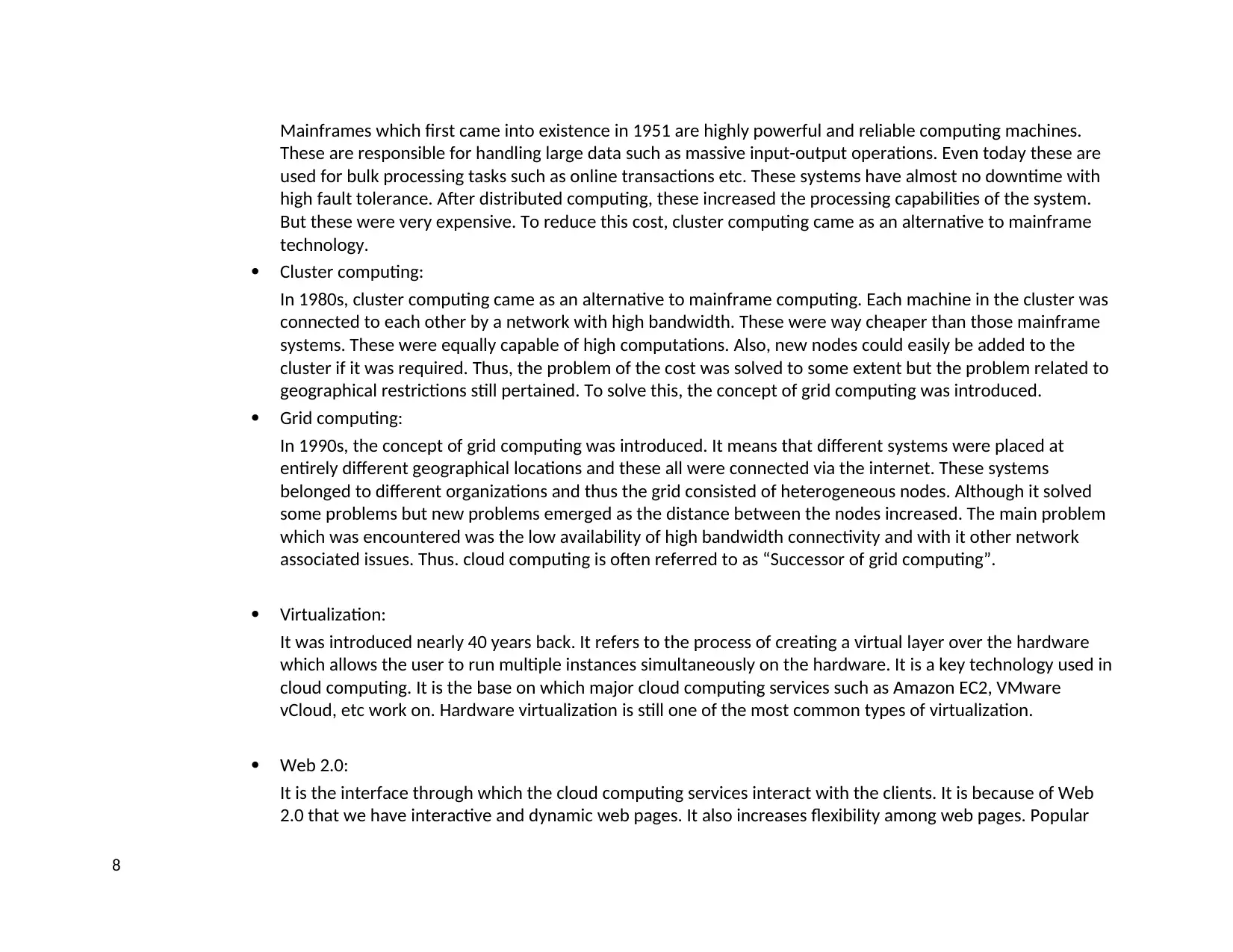
Mainframes which first came into existence in 1951 are highly powerful and reliable computing machines.
These are responsible for handling large data such as massive input-output operations. Even today these are
used for bulk processing tasks such as online transactions etc. These systems have almost no downtime with
high fault tolerance. After distributed computing, these increased the processing capabilities of the system.
But these were very expensive. To reduce this cost, cluster computing came as an alternative to mainframe
technology.
Cluster computing:
In 1980s, cluster computing came as an alternative to mainframe computing. Each machine in the cluster was
connected to each other by a network with high bandwidth. These were way cheaper than those mainframe
systems. These were equally capable of high computations. Also, new nodes could easily be added to the
cluster if it was required. Thus, the problem of the cost was solved to some extent but the problem related to
geographical restrictions still pertained. To solve this, the concept of grid computing was introduced.
Grid computing:
In 1990s, the concept of grid computing was introduced. It means that different systems were placed at
entirely different geographical locations and these all were connected via the internet. These systems
belonged to different organizations and thus the grid consisted of heterogeneous nodes. Although it solved
some problems but new problems emerged as the distance between the nodes increased. The main problem
which was encountered was the low availability of high bandwidth connectivity and with it other network
associated issues. Thus. cloud computing is often referred to as “Successor of grid computing”.
Virtualization:
It was introduced nearly 40 years back. It refers to the process of creating a virtual layer over the hardware
which allows the user to run multiple instances simultaneously on the hardware. It is a key technology used in
cloud computing. It is the base on which major cloud computing services such as Amazon EC2, VMware
vCloud, etc work on. Hardware virtualization is still one of the most common types of virtualization.
Web 2.0:
It is the interface through which the cloud computing services interact with the clients. It is because of Web
2.0 that we have interactive and dynamic web pages. It also increases flexibility among web pages. Popular
8
These are responsible for handling large data such as massive input-output operations. Even today these are
used for bulk processing tasks such as online transactions etc. These systems have almost no downtime with
high fault tolerance. After distributed computing, these increased the processing capabilities of the system.
But these were very expensive. To reduce this cost, cluster computing came as an alternative to mainframe
technology.
Cluster computing:
In 1980s, cluster computing came as an alternative to mainframe computing. Each machine in the cluster was
connected to each other by a network with high bandwidth. These were way cheaper than those mainframe
systems. These were equally capable of high computations. Also, new nodes could easily be added to the
cluster if it was required. Thus, the problem of the cost was solved to some extent but the problem related to
geographical restrictions still pertained. To solve this, the concept of grid computing was introduced.
Grid computing:
In 1990s, the concept of grid computing was introduced. It means that different systems were placed at
entirely different geographical locations and these all were connected via the internet. These systems
belonged to different organizations and thus the grid consisted of heterogeneous nodes. Although it solved
some problems but new problems emerged as the distance between the nodes increased. The main problem
which was encountered was the low availability of high bandwidth connectivity and with it other network
associated issues. Thus. cloud computing is often referred to as “Successor of grid computing”.
Virtualization:
It was introduced nearly 40 years back. It refers to the process of creating a virtual layer over the hardware
which allows the user to run multiple instances simultaneously on the hardware. It is a key technology used in
cloud computing. It is the base on which major cloud computing services such as Amazon EC2, VMware
vCloud, etc work on. Hardware virtualization is still one of the most common types of virtualization.
Web 2.0:
It is the interface through which the cloud computing services interact with the clients. It is because of Web
2.0 that we have interactive and dynamic web pages. It also increases flexibility among web pages. Popular
8
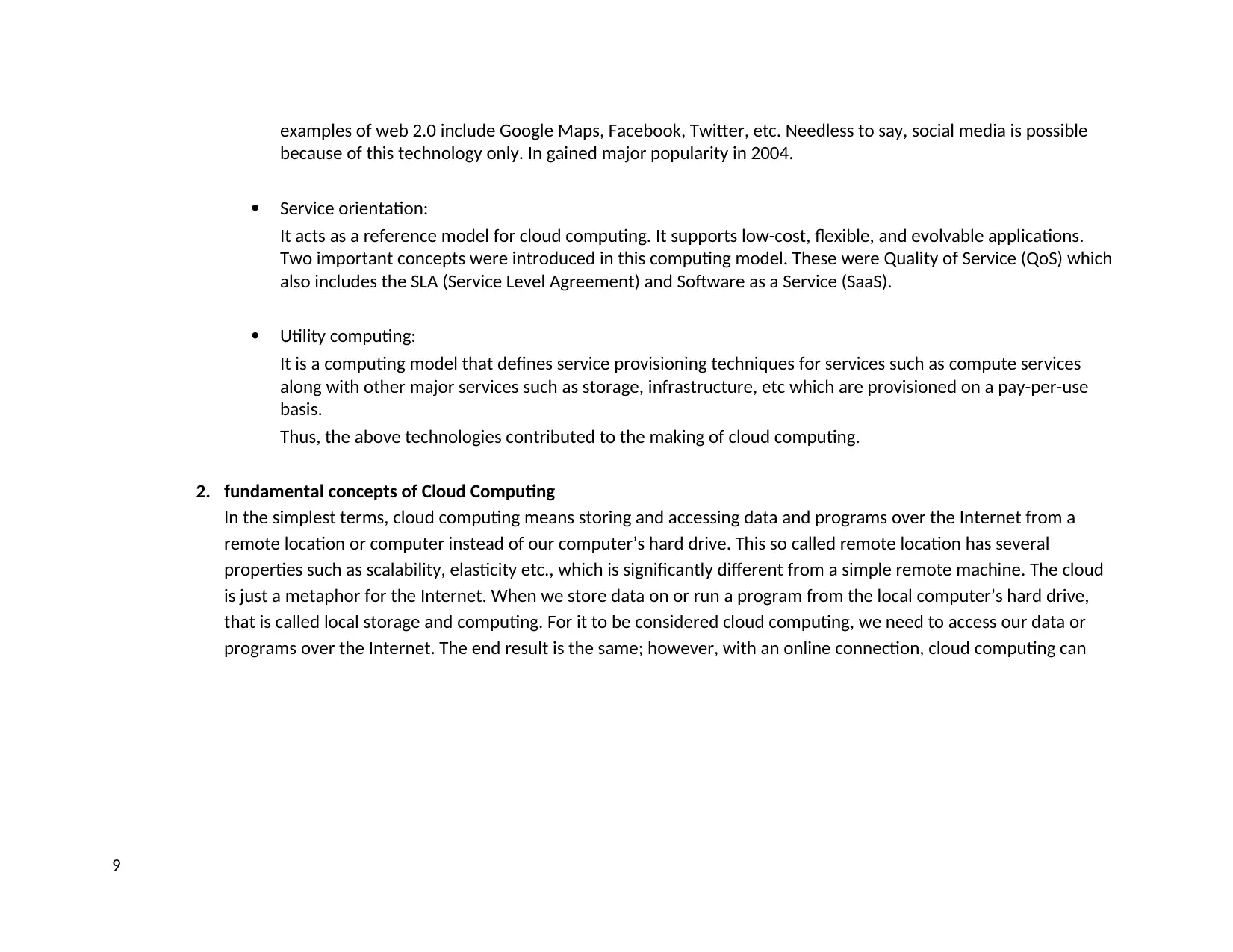
examples of web 2.0 include Google Maps, Facebook, Twitter, etc. Needless to say, social media is possible
because of this technology only. In gained major popularity in 2004.
Service orientation:
It acts as a reference model for cloud computing. It supports low-cost, flexible, and evolvable applications.
Two important concepts were introduced in this computing model. These were Quality of Service (QoS) which
also includes the SLA (Service Level Agreement) and Software as a Service (SaaS).
Utility computing:
It is a computing model that defines service provisioning techniques for services such as compute services
along with other major services such as storage, infrastructure, etc which are provisioned on a pay-per-use
basis.
Thus, the above technologies contributed to the making of cloud computing.
2. fundamental concepts of Cloud Computing
In the simplest terms, cloud computing means storing and accessing data and programs over the Internet from a
remote location or computer instead of our computer’s hard drive. This so called remote location has several
properties such as scalability, elasticity etc., which is significantly different from a simple remote machine. The cloud
is just a metaphor for the Internet. When we store data on or run a program from the local computer’s hard drive,
that is called local storage and computing. For it to be considered cloud computing, we need to access our data or
programs over the Internet. The end result is the same; however, with an online connection, cloud computing can
9
because of this technology only. In gained major popularity in 2004.
Service orientation:
It acts as a reference model for cloud computing. It supports low-cost, flexible, and evolvable applications.
Two important concepts were introduced in this computing model. These were Quality of Service (QoS) which
also includes the SLA (Service Level Agreement) and Software as a Service (SaaS).
Utility computing:
It is a computing model that defines service provisioning techniques for services such as compute services
along with other major services such as storage, infrastructure, etc which are provisioned on a pay-per-use
basis.
Thus, the above technologies contributed to the making of cloud computing.
2. fundamental concepts of Cloud Computing
In the simplest terms, cloud computing means storing and accessing data and programs over the Internet from a
remote location or computer instead of our computer’s hard drive. This so called remote location has several
properties such as scalability, elasticity etc., which is significantly different from a simple remote machine. The cloud
is just a metaphor for the Internet. When we store data on or run a program from the local computer’s hard drive,
that is called local storage and computing. For it to be considered cloud computing, we need to access our data or
programs over the Internet. The end result is the same; however, with an online connection, cloud computing can
9
⊘ This is a preview!⊘
Do you want full access?
Subscribe today to unlock all pages.

Trusted by 1+ million students worldwide
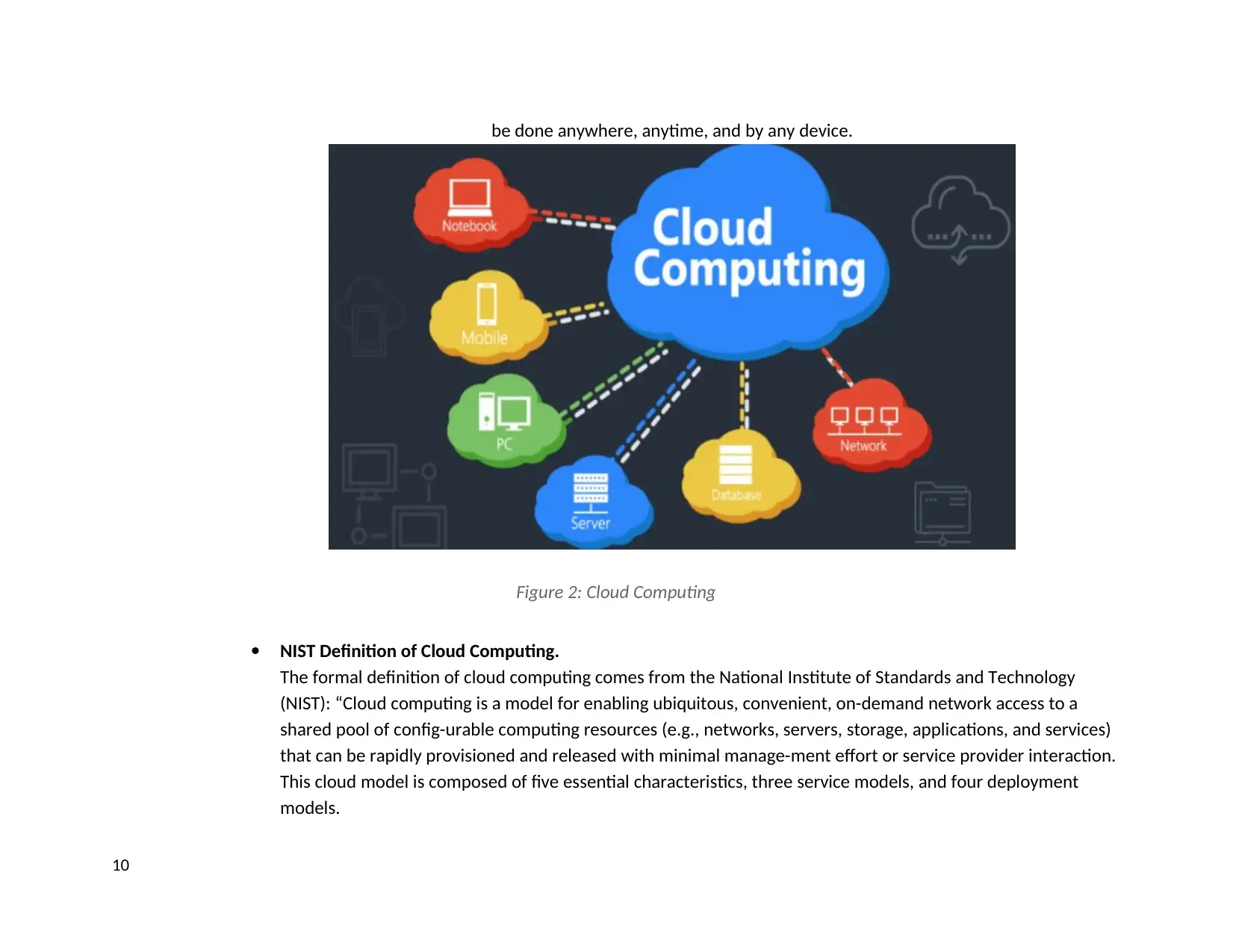
be done anywhere, anytime, and by any device.
Figure 2: Cloud Computing
NIST Definition of Cloud Computing.
The formal definition of cloud computing comes from the National Institute of Standards and Technology
(NIST): “Cloud computing is a model for enabling ubiquitous, convenient, on-demand network access to a
shared pool of config-urable computing resources (e.g., networks, servers, storage, applications, and services)
that can be rapidly provisioned and released with minimal manage-ment effort or service provider interaction.
This cloud model is composed of five essential characteristics, three service models, and four deployment
models.
10
Figure 2: Cloud Computing
NIST Definition of Cloud Computing.
The formal definition of cloud computing comes from the National Institute of Standards and Technology
(NIST): “Cloud computing is a model for enabling ubiquitous, convenient, on-demand network access to a
shared pool of config-urable computing resources (e.g., networks, servers, storage, applications, and services)
that can be rapidly provisioned and released with minimal manage-ment effort or service provider interaction.
This cloud model is composed of five essential characteristics, three service models, and four deployment
models.
10
Paraphrase This Document
Need a fresh take? Get an instant paraphrase of this document with our AI Paraphraser
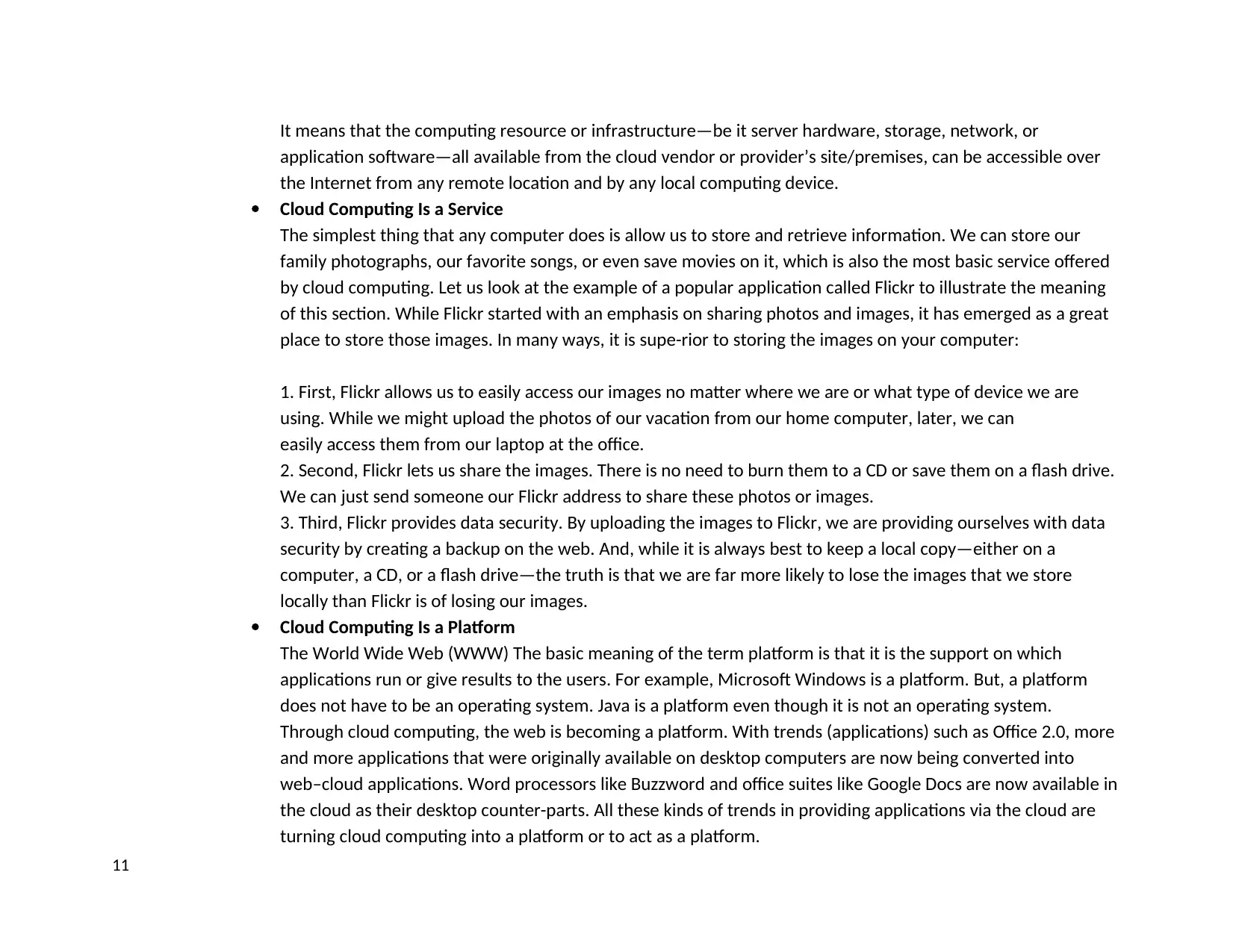
It means that the computing resource or infrastructure—be it server hardware, storage, network, or
application software—all available from the cloud vendor or provider’s site/premises, can be accessible over
the Internet from any remote location and by any local computing device.
Cloud Computing Is a Service
The simplest thing that any computer does is allow us to store and retrieve information. We can store our
family photographs, our favorite songs, or even save movies on it, which is also the most basic service offered
by cloud computing. Let us look at the example of a popular application called Flickr to illustrate the meaning
of this section. While Flickr started with an emphasis on sharing photos and images, it has emerged as a great
place to store those images. In many ways, it is supe-rior to storing the images on your computer:
1. First, Flickr allows us to easily access our images no matter where we are or what type of device we are
using. While we might upload the photos of our vacation from our home computer, later, we can
easily access them from our laptop at the office.
2. Second, Flickr lets us share the images. There is no need to burn them to a CD or save them on a flash drive.
We can just send someone our Flickr address to share these photos or images.
3. Third, Flickr provides data security. By uploading the images to Flickr, we are providing ourselves with data
security by creating a backup on the web. And, while it is always best to keep a local copy—either on a
computer, a CD, or a flash drive—the truth is that we are far more likely to lose the images that we store
locally than Flickr is of losing our images.
Cloud Computing Is a Platform
The World Wide Web (WWW) The basic meaning of the term platform is that it is the support on which
applications run or give results to the users. For example, Microsoft Windows is a platform. But, a platform
does not have to be an operating system. Java is a platform even though it is not an operating system.
Through cloud computing, the web is becoming a platform. With trends (applications) such as Office 2.0, more
and more applications that were originally available on desktop computers are now being converted into
web–cloud applications. Word processors like Buzzword and office suites like Google Docs are now available in
the cloud as their desktop counter-parts. All these kinds of trends in providing applications via the cloud are
turning cloud computing into a platform or to act as a platform.
11
application software—all available from the cloud vendor or provider’s site/premises, can be accessible over
the Internet from any remote location and by any local computing device.
Cloud Computing Is a Service
The simplest thing that any computer does is allow us to store and retrieve information. We can store our
family photographs, our favorite songs, or even save movies on it, which is also the most basic service offered
by cloud computing. Let us look at the example of a popular application called Flickr to illustrate the meaning
of this section. While Flickr started with an emphasis on sharing photos and images, it has emerged as a great
place to store those images. In many ways, it is supe-rior to storing the images on your computer:
1. First, Flickr allows us to easily access our images no matter where we are or what type of device we are
using. While we might upload the photos of our vacation from our home computer, later, we can
easily access them from our laptop at the office.
2. Second, Flickr lets us share the images. There is no need to burn them to a CD or save them on a flash drive.
We can just send someone our Flickr address to share these photos or images.
3. Third, Flickr provides data security. By uploading the images to Flickr, we are providing ourselves with data
security by creating a backup on the web. And, while it is always best to keep a local copy—either on a
computer, a CD, or a flash drive—the truth is that we are far more likely to lose the images that we store
locally than Flickr is of losing our images.
Cloud Computing Is a Platform
The World Wide Web (WWW) The basic meaning of the term platform is that it is the support on which
applications run or give results to the users. For example, Microsoft Windows is a platform. But, a platform
does not have to be an operating system. Java is a platform even though it is not an operating system.
Through cloud computing, the web is becoming a platform. With trends (applications) such as Office 2.0, more
and more applications that were originally available on desktop computers are now being converted into
web–cloud applications. Word processors like Buzzword and office suites like Google Docs are now available in
the cloud as their desktop counter-parts. All these kinds of trends in providing applications via the cloud are
turning cloud computing into a platform or to act as a platform.
11
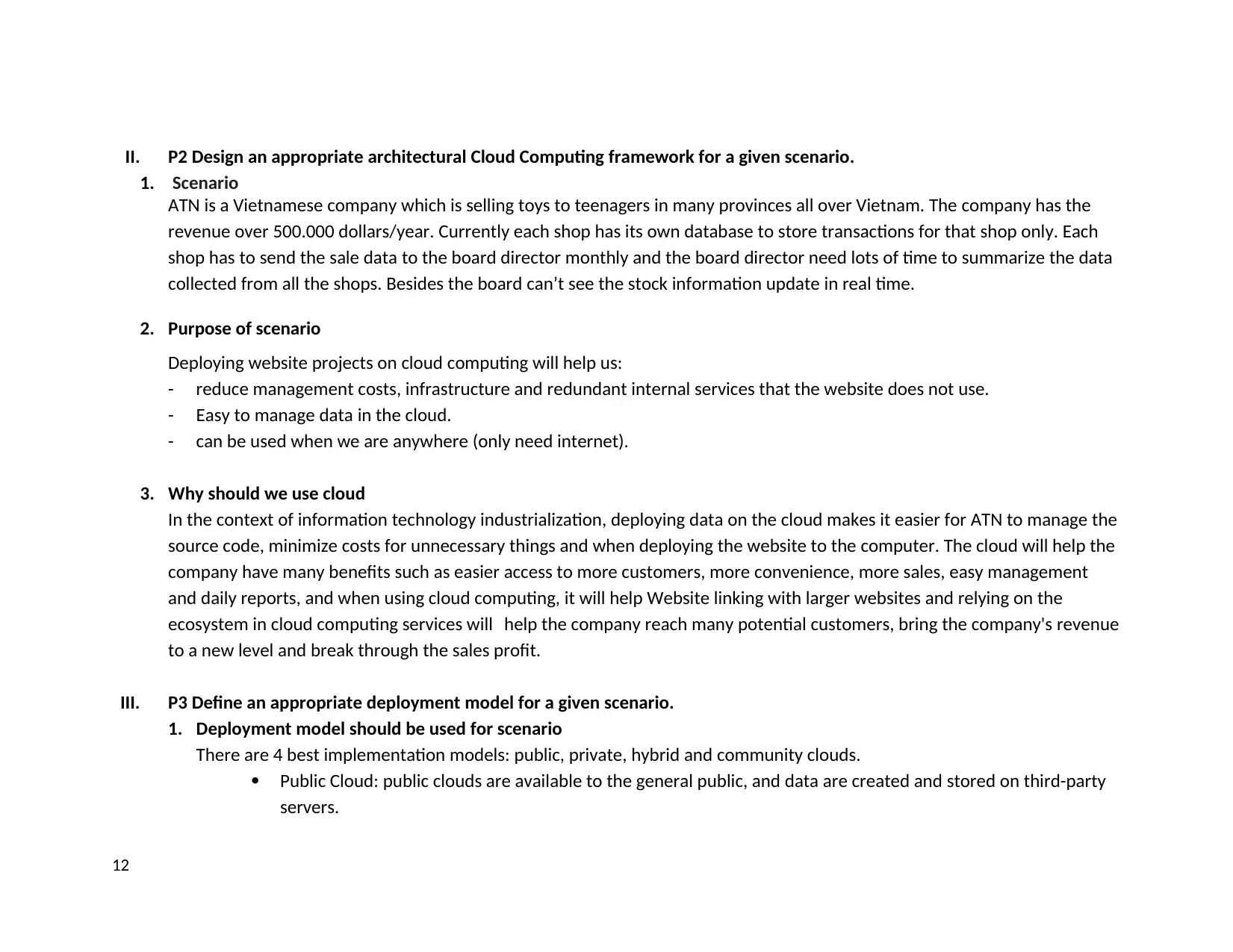
II. P2 Design an appropriate architectural Cloud Computing framework for a given scenario.
1. Scenario
ATN is a Vietnamese company which is selling toys to teenagers in many provinces all over Vietnam. The company has the
revenue over 500.000 dollars/year. Currently each shop has its own database to store transactions for that shop only. Each
shop has to send the sale data to the board director monthly and the board director need lots of time to summarize the data
collected from all the shops. Besides the board can’t see the stock information update in real time.
2. Purpose of scenario
Deploying website projects on cloud computing will help us:
- reduce management costs, infrastructure and redundant internal services that the website does not use.
- Easy to manage data in the cloud.
- can be used when we are anywhere (only need internet).
3. Why should we use cloud
In the context of information technology industrialization, deploying data on the cloud makes it easier for ATN to manage the
source code, minimize costs for unnecessary things and when deploying the website to the computer. The cloud will help the
company have many benefits such as easier access to more customers, more convenience, more sales, easy management
and daily reports, and when using cloud computing, it will help Website linking with larger websites and relying on the
ecosystem in cloud computing services will help the company reach many potential customers, bring the company's revenue
to a new level and break through the sales profit.
III. P3 Define an appropriate deployment model for a given scenario.
1. Deployment model should be used for scenario
There are 4 best implementation models: public, private, hybrid and community clouds.
Public Cloud: public clouds are available to the general public, and data are created and stored on third-party
servers.
12
1. Scenario
ATN is a Vietnamese company which is selling toys to teenagers in many provinces all over Vietnam. The company has the
revenue over 500.000 dollars/year. Currently each shop has its own database to store transactions for that shop only. Each
shop has to send the sale data to the board director monthly and the board director need lots of time to summarize the data
collected from all the shops. Besides the board can’t see the stock information update in real time.
2. Purpose of scenario
Deploying website projects on cloud computing will help us:
- reduce management costs, infrastructure and redundant internal services that the website does not use.
- Easy to manage data in the cloud.
- can be used when we are anywhere (only need internet).
3. Why should we use cloud
In the context of information technology industrialization, deploying data on the cloud makes it easier for ATN to manage the
source code, minimize costs for unnecessary things and when deploying the website to the computer. The cloud will help the
company have many benefits such as easier access to more customers, more convenience, more sales, easy management
and daily reports, and when using cloud computing, it will help Website linking with larger websites and relying on the
ecosystem in cloud computing services will help the company reach many potential customers, bring the company's revenue
to a new level and break through the sales profit.
III. P3 Define an appropriate deployment model for a given scenario.
1. Deployment model should be used for scenario
There are 4 best implementation models: public, private, hybrid and community clouds.
Public Cloud: public clouds are available to the general public, and data are created and stored on third-party
servers.
12
⊘ This is a preview!⊘
Do you want full access?
Subscribe today to unlock all pages.

Trusted by 1+ million students worldwide
1 out of 27
Related Documents
Your All-in-One AI-Powered Toolkit for Academic Success.
+13062052269
info@desklib.com
Available 24*7 on WhatsApp / Email
![[object Object]](/_next/static/media/star-bottom.7253800d.svg)
Unlock your academic potential
Copyright © 2020–2025 A2Z Services. All Rights Reserved. Developed and managed by ZUCOL.





